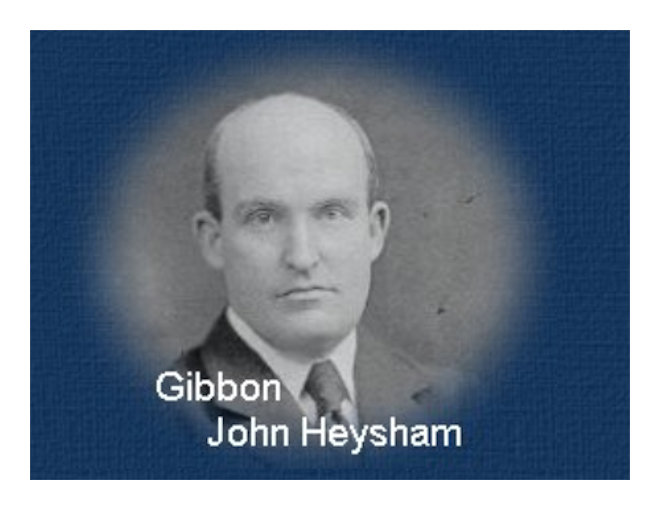John Heysham Gibbon
Célébrités en cardiologie
(Celebrities in cardiology)

John Heysham Gibbon © Heart and Coeur ©
 John Heysham Gibbon
John Heysham Gibbon
La machine coeur-poumons (CEC)
John Heysham Gibbon (1903-1973) est né à Philadelphie
John Heysham Gibbon, est le premier chercheur a avoir développé une machine coeur-poumon qui peut pleinement remplacer les fonctions cardiaques et respiratoires d'un adulte pendant une intervention chirurgicale cardiaque pour réparer des anomalies dans le coeur et les poumons.
La difficulté d'une telle tâche peut être vue dans le nombre de personnes qui l'ont essayé pendant plus d'un siécle... la liste est longue.
Gibbon a réussi le 6 mai 1953, lors d'une intervention cardiaque de type CIA sur patient tenu entiérement en vie par la machine pendant 27 minutes.
ADA Romaine-Davis affirme que peu de gens se rendent compte du temps que passa GIBBON a travailler pour réaliser ce succés.
Pour rectifier la situation, Romaine-Davis ici fournit une étude compléte de Gibbon et de son accomplissement.
Elle montre comment Gibbon surmonte le découragement et les problémes vis a vis de ses détracteurs et mentors et a ainsi obtenu l'appui crucial du Président Thomas Watson de conseil d'IBM.
Elle examine chacun des modéles produits par Gibbon et met son accomplissement dans la perspective historique.
Gibbon lui-même a choisi de ne pas poursuivre la chirurgie cardiaque; il est resté un chirurgien thoracique.
D'autres ont continué a développer la connaissance et les qualifications qui rendent aujourd'hui la chirurgie à coeur-ouvert
aussi sûre que d'autres procédures chirurgicales banales.
 John Heysham Gibbon
John Heysham Gibbon
The heart-lung machine
John Heysham Gibbon (1903-1973) Born -- Philadelphia
John Heysham Gibbon, Jr., M.D., was the first researcher to develop a heart-lung machine that could fully support an adult's cardiac and respiratory functions during surgical procedures to repair defects in the heart and lungs.
The difficulty of such a task can be seen in the number of people who attempted it for over a century: the list is long.
Gibbon succeeded on May 6, 1953, when he repaired an atrial-septal defect with the patient supported entirely by the machine for 27 minutes.
Ada Romaine-Davis contends that few realize how long Gibbon worked to achieve this success.
To rectify the situation, Romaine-Davis here provides a thorough study of Gibbon and his accomplishment. She shows how Gibbon overcame discouragement from his peers and mentors and obtained crucial support from IBM Board Chairman Thomas Watson.
She examines each of the models produced by Gibbon and puts his achievement into historical perspective. Gibbon himself chose not to pursue cardiac surgery; he remained a thoracic surgeon.
Others went on to develop the knowledge and skills that today make open-heart surgery as safe as other major surgical procedures.
As Romaine-Davis amply demonstrates, these pioneers stand on the shoulders of a stubborn, persevering, single-minded genius whose determination to leave a legacy to his profession resulted in the one thing essential for sustained progress in heart surgery: John Gibbon's heart-lung machine. This meticulously researched study will make fascinating reading for physicians--especially surgeons--as well as for students and scholars of medical history and science and technology.



